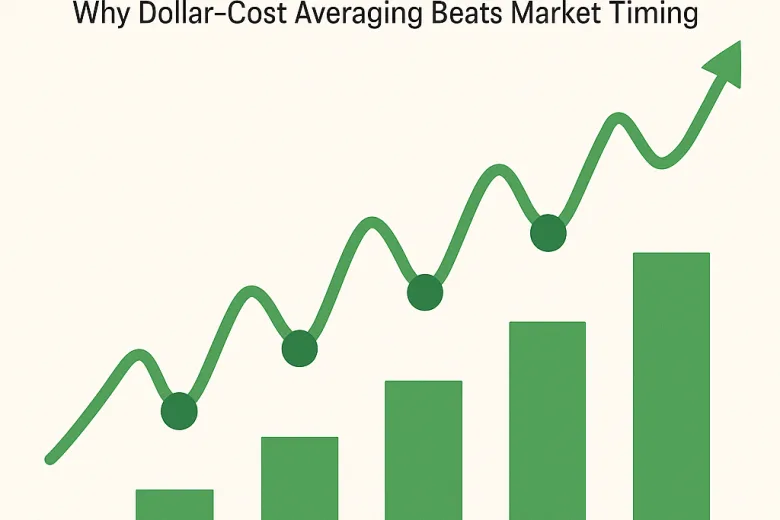Investing success isn’t about predicting the perfect moment — it’s about consistency.
That’s the core idea behind Dollar-Cost Averaging (DCA), an investing strategy that quietly beats the flashy appeal of market timing. If you’re aiming to build wealth steadily — without the stress of calling tops and bottoms — DCA is a strategy worth understanding and adopting.
In this article, we’ll break down what dollar-cost averaging is, why the mantra Always Be Buying works in your favor, and how this approach helps you outperform the market-timers over the long run.
What Is Dollar-Cost Averaging?
Dollar-Cost Averaging is the practice of investing a fixed amount of money on a regular schedule, regardless of market conditions.
Instead of waiting for the “right” time to invest a lump sum, you spread your purchases over weeks, months, or even years. For example:
- $500 per month into an S&P 500 index fund
- $100 every two weeks into your favorite dividend stock
- $200 per paycheck into your 401(k)
With DCA, you automatically buy more shares when prices are low and fewer shares when prices are high. Over time, this can lower your average cost per share and smooth out the effects of short-term volatility.
Why Dollar-Cost Averaging Works
1. It Removes Emotion From Investing
Market timing sounds great in theory: “Buy low, sell high.”
But in practice, it’s nearly impossible to execute consistently.
When markets crash, fear makes it hard to hit the buy button.
When markets soar, greed can lure you into buying at inflated prices.
DCA bypasses these emotional traps. With a regular schedule, your plan stays on track whether the market is euphoric or panicked. You become disciplined, not reactive.
2. It Lowers Average Cost Over Time
Volatile markets actually help DCA investors.
Imagine this simplified scenario:
| Month | Share Price | Amount Invested | Shares Bought |
|---|---|---|---|
| Jan | $50 | $500 | 10 |
| Feb | $25 | $500 | 20 |
| Mar | $33 | $500 | ~15.15 |
Even though prices fluctuate, your average cost per share is lower than if you had invested all $1500 when shares were $50.
DCA turns volatility into an advantage. You buy dips automatically — no market timing required.
3. It Keeps You Invested (And That’s Half the Battle)
Study after study shows that being in the market beats trying to time the market.
JP Morgan analyzed S&P 500 returns from 2003–2022. If you missed the 10 best days during that 20-year span, your return was cut in half.
The problem? The best days often cluster around the worst days — meaning market-timers frequently miss the rebounds.
Dollar-cost averaging ensures you stay consistently invested, capturing both the downturns and the critical rebounds.
The “Always Be Buying” Mindset
Dollar-Cost Averaging is more than just a strategy — it’s a philosophy:
Always Be Buying.
This mindset embraces the fact that:
- Markets are unpredictable in the short term
- Long-term growth is driven by staying invested
- You don’t need to be perfect — you need to be consistent
Whether stocks are up or down this week doesn’t matter. If you’re investing for decades, every purchase builds your future wealth.
But What About Lump-Sum Investing?
Lump-sum investing can outperform DCA in some cases — if you’re sitting on a large cash pile and the market trend is positive.
Historically, markets rise more often than they fall, so investing all at once mathematically has a slight edge.
However:
- Most people don’t have a large lump sum to invest — they invest paycheck by paycheck
- DCA protects you from the risk of investing a lump sum right before a market drop
- The behavioral benefits of DCA (reduced emotion, increased discipline) often outweigh the theoretical performance difference
For most investors, DCA offers the right blend of practicality and psychological safety.
Final Thoughts: Why You Should DCA (and Keep It Simple)
If you want to build wealth, remember this:
It’s not about perfect timing. It’s about time in the market.
Dollar-Cost Averaging gives you a proven system to:
- Stay consistent
- Buy through volatility
- Avoid emotional mistakes
- Capture long-term market growth
So whether the headlines scream “Recession!” or “Record Highs!”, your strategy stays the same:
Always be buying.
